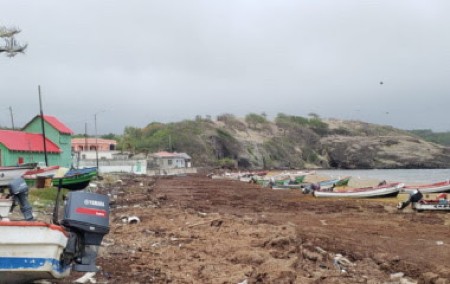Regional Project Being Developed to Turn Sargassum Seaweed Into Commercial Products
BELMOPAN, Belize – The Belize-based Caribbean Regional Fisheries Mechanism (CRFM) says it is advancing a regional project aimed at turning Sargassum into innovative products that will create jobs and income as well as contribute to building the region’s climate resilience.
 Sargassum inundation defaces coastline of Saint Lucia fishing community (CRFM photo)CRFM said it is working with Plant & Food Research (PFR), a New Zealand government-owned Crown Research Institute on the project that is also aimed at mitigating the negative impacts of Sargassum in the region.
Sargassum inundation defaces coastline of Saint Lucia fishing community (CRFM photo)CRFM said it is working with Plant & Food Research (PFR), a New Zealand government-owned Crown Research Institute on the project that is also aimed at mitigating the negative impacts of Sargassum in the region.
It said during this year, the two entities in partnership with other public and private sector institutions in the Caribbean region, will focus on lab-scale work and field trials to develop suitable prototype products from the Sargassum seaweed for commercial use.
As a result, a team from the CRFM Secretariat and Plant & Food Research recently visited Trinidad and Tobago and Barbados to meet with key stakeholders as they advance the second phase of the project titled, “Developing Sargassum Products for Climate Resilience in the Caribbean”.
“Sargassum remains a major problem for our countries, coastal communities, and business enterprises, especially those in the fisheries and tourism sectors operating in the coastal and marine environment. “We had a very productive mission to Barbados and Trinidad and Tobago meeting with partners and stakeholders with an interest in creating value-added products from the Sargassum,” said CRFM executive director, Milton Haughton.
“We are very confident that we can work together with interested partners to develop viable products and generate jobs and income streams for our people from this natural resource (Sargassum) that has been inundating our waters and beaches over the past 12 years. Our focus now is on developing and testing these prototype products and processes using the Sargassum. We will also be developing a product commercialization strategy,” he added.
The International Development Program Manager at Plant & Food Research, Rosie Paterson-Lima, said her organisation’s involvement was made possible by funding from the New Zealand government International Development Cooperation Programme.
“It is exciting for us to work in partnership in the region on this challenge, and to bring our expertise in agronomy, value chain analysis, and commercialisation. Together our goal is to minimise the problems caused by Sargassum by creating viable economic opportunities for the region.
“We are delighted to have Barbadian Dr Terrell Thompson joining the project delivery team recently as a consultant. Dr Thompson is a chemicals and materials engineer with impressive expertise and experience in the Sargassum industry,” Paterson-Lima said.
While in Trinidad and Tobago the team met with several stakeholders including the Trinidad and Tobago government, the Caribbean Agricultural Research and Development Institute (CARDI), the Caribbean Public Health Agency (CARPHA), the Caribbean Industrial Research Institute (CARIRI) and the Engineering Faculty of the University of the West Indies as well as the Association of Caribbean States and the Caribbean Private Sector Organisation (CPSO).
The visit to Barbados resulted in discussions with officials of the Ministry of Agriculture, Fisheries Division, and the National Conservation Commission, the European Union and the Food and Agricultural Organisation (FAO).
The CRFM said that it is successfully completed the first phase of the project, working with partners in Barbados, Belize, Jamaica, and the Dominican Republic to conduct Sargassum raw material safety testing and review of potential products that could be made from the Sargassum.
It said the second phase of the project will entail product and process development.
Meanwhile, the CRFM says Sargassum blooms in the Atlantic have already begun, and they are expected to inundate the Caribbean region by April 2023.
It said the outlook for 2023 Sargassum blooms in the Caribbean Sea and Gulf of Mexico, released by the University of South Florida Optical Oceanography Lab earlier this month, revealed that, “the overall Sargassum quantity in the Atlantic Ocean doubled from December 2022 to January 2023 (8.7 million tons), again setting a new record (previous January record was 6.5 million tons in 2018)”.
The outlook noted that this is the second consecutive monthly doubling of Sargassum, previously observed only in 2018, and all indications are that the Sargassum biomass will continue to accumulate and migrate westward over the next several months.
“Climate change has been identified as one of the major contributing factors to this phenomenon which has been affecting our region and principally our coastal fishing communities for the past 12 years.
“The CRFM-Plant & Food Research collaboration will identify and use appropriate sustainable technologies for efficient harvesting of Sargassum, according to international best practices. The final phase is outreach and supply chain development, which would entail the dissemination of a model to industry stakeholders and wider Caribbean,” the CRFM added.


